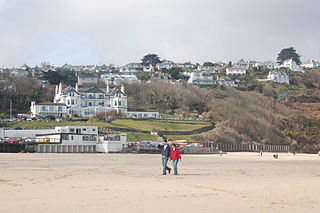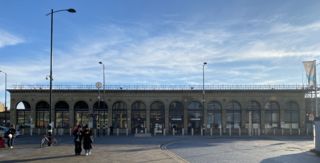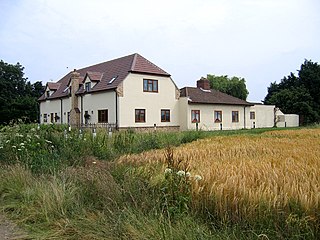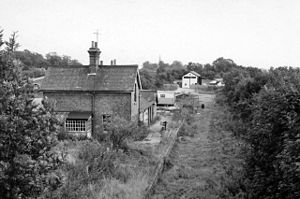
Carbis Bay is a seaside resort and village in Cornwall, England. It lies 1 mile (1.6 km) southeast of St Ives, on the western coast of St Ives Bay, on the Atlantic coast. The South West Coast Path passes above the beach.

The St Ives Bay Line is a 4.25 miles (6.84 km) railway line from St Erth to St Ives in Cornwall, England, United Kingdom. It was opened in 1877, the last new 7 ft broad gauge passenger railway to be constructed in the country. Converted to standard gauge in 1892, it continues to operate as a community railway, carrying tourists as well as local passengers. It has five stations including the junction with the Cornish Main Line at St Erth.

Cambridge railway station is the principal station serving the city of Cambridge in the east of England. It stands at the end of Station Road, 1 mile (1.6 km) south-east of the city centre. It is the northern terminus of the West Anglia Main Line, 55 miles 52 chains (89.6 km) down the line from London Liverpool Street, the southern terminus.

Bluntisham is a village and civil parish in Cambridgeshire, England. The population of the civil parish as of the 2011 census is 2,003. Bluntisham lies approximately 8 miles (13 km) east of Huntingdon. Bluntisham is situated within Huntingdonshire which is a non-metropolitan district of Cambridgeshire as well as being a historic county of England. The villages of Earith, Colne, Woodhurst, and Somersham are all close by.

St Erth railway station is a Grade II listed station situated at Rose-an-Grouse in Cornwall, United Kingdom. It serves the nearby village of St Erth, which is about 0.75 miles (1.21 km) away, and is the junction for the St Ives Bay Line to St Ives. The station is 321 miles (517 km) measured from London Paddington via Bristol Temple Meads.

St Ives railway station is a railway station which serves the coastal town of St Ives, Cornwall, England. It was opened in 1877 as the terminus of the last new broad gauge passenger railway to be constructed in the country. Converted to standard gauge in 1892, it is today served by Great Western Railway services on the St Ives Bay Line from St Erth. It is 325 miles (523 km) from London Paddington via Bristol Temple Meads.

Carbis Bay railway station is on the St Ives Bay Line in Cornwall, United Kingdom and serves the village and beach of Carbis Bay, a community that only adopted this name after the arrival of the railway in 1877. It is 324 miles (521 km) from London Paddington via Bristol Temple Meads. Carbis Viaduct is situated on the St Ives (west) side of the station.

Lelant railway station is on the waterfront of the Hayle estuary below the village of Lelant in Cornwall, United Kingdom. It is 322 miles (518 km) from London Paddington via Bristol Temple Meads.

Lelant Saltings railway station was opened on 27 May 1978 to provide a park and ride facility for visitors to St Ives, Cornwall, England. It is situated on the A3074 road close to the junction with the A30 near the foot of the hill up to Lelant village. The park and ride facility closed in June 2019, replaced by a new one at nearby St Erth railway station, but the Saltings station remains open with a very limited service of trains.
The Ely and St Ives Railway was a railway company that opened a line between those places in 1878. It was an extension of the privately promoted Ely, Haddenham & Sutton Railway that had opened in 1866. It was a standard gauge single track. The line was worked by the neighbouring Great Eastern Railway but it was never profitable. The development of road transport services in the 1920s caused a steep decline in use of the line, and the passenger service was withdrawn in 1931. A goods service continued, but the line closed completely in 1964. No railway activity takes place on the route now.
The Cambridge and St Ives branch was a railway built by the Wisbech, St Ives & Cambridge Junction Railway in the late 1840s. The railway ran from Cambridge in the south, through Fenland countryside to the market town of St Ives; more specifically, the line ran from Chesterton Junction, where it met the present-day Fen line north of the River Cam.
Earith is a village and civil parish in Cambridgeshire, England. Earith lies approximately 10 miles (16 km) east of Huntingdon. Earith is situated within Huntingdonshire which is a non-metropolitan district of Cambridgeshire as well as being a historic county of England. At Earith, two artificial diversion channels of the River Great Ouse, the Old Bedford River and the New Bedford River, leave the river on a course to Denver Sluice near Downham Market, where they rejoin the Great Ouse in its tidal part. At the 2001 census, the parish had a population of 1,677, reducing to 1,606 at the 2011 Census.
The Great Northern and Great Eastern Joint Railway, colloquially referred to as "the Joint Line" was a railway line connecting Doncaster and Lincoln with March and Huntingdon in the eastern counties of England. It was owned jointly by the Great Northern Railway (GNR) and the Great Eastern Railway (GER). It was formed by transferring certain route sections from the parent companies, and by the construction of a new route between Spalding and Lincoln, and a number of short spurs and connections. It was controlled by a Joint Committee, and the owning companies operated their own trains with their own rolling stock. The Joint Line amounted to nearly 123 miles (198 km) of route.
St Ives railway station is a former railway station in St Ives, Cambridgeshire. It formed a junction, with lines to the east heading towards Cambridge, north towards Ely and March and west towards Godmanchester. It opened on 19 August 1847, closed on 5 October 1970, and was demolished in 1977. The site is now occupied by the St. Ives "Park and Ride" area.

Earith Bridge railway station was a station in Earith, Cambridgeshire on the Ely and St Ives Railway. It was closed to regular passenger trains in 1931 but occasional excursions used it until 1958.
Sutton railway station was a station in Sutton, Cambridgeshire on the Ely and St Ives Railway.

Wilburton railway station was a station in Wilburton, Cambridgeshire on the Ely and St Ives Railway. It was closed to regular passenger trains in 1931, excursion trains in 1958, and completely in 1964 along with the rest of the route.

Stretham railway station was a station in Stretham, Cambridgeshire on the Ely and St Ives Railway.

Hurstingstone was a hundred of Huntingdonshire, England that was mentioned in the Domesday Book of 1086.













